Seismic Performance of Story-Added Type Buildings Remodeled with Story Seismic Isolation Systems
Abstract
:1. Background
2. Seismic Isolation Systems for Old Building Remodeling by Adding Stories
3. Preliminary Analysis
3.1. Model of Preliminary Analysis
3.2. Results of Analysis
3.2.1. Effect of Seismic Isolation on One Story Added to a Building
3.2.2. Effect of Seismic Isolation on Two Stories Added to a Building
3.2.3. Effect of Seismic Isolation on Three Stories Added to a Building
4. Evaluation of the Applicability of a Seismic Isolation System for Remodeling an Apartment Building with Stories Added
4.1. Research Model
4.2. Wind and Seismic Loads
4.3. Design and Arrangement of the Seismic Isolation Device
4.3.1. Target Period of Seismic Isolation
4.3.2. Effective Rigidity of the Seismic Isolation System
4.3.3. Design of Seismic Isolation Device and Arrangement of Seismic Isolation System
4.3.4. Examination of Wind Load
4.3.5. Calculation of Minimum Horizontal Displacement
4.4. Incident Earthquake Vibration
4.5. Results
5. Conclusions
- (1)
- The optimal period of seismic isolation according to the story added to each story of a building was examined by exploiting dynamic characteristics of the frame of the building. Findings revealed that adding a three-story (or a two-story) to a seismically isolated building with a period of seismic isolation that was more than twice (or thrice) as long as that of a non-seismically isolated counterpart might produce a suitable seismic isolation effect. In the case of the addition of one story, the sufficient seismic isolation effect was realized with a period of seismic isolation that was more than four times that of the non-seismically isolated building.
- (2)
- The seismic isolation system was applied to a building with a three-story addition. The maximum response acceleration at the top of the seismically isolated building showed approximately 70% and 65% decreases in X- and Y-directions, respectively, compared to those of the non-seismically isolated building. Furthermore, regarding the shearing force at the base plane, the maximum response acceleration showed decreases of approximately 30% in both the X- and Y-directions. The decrease in story-shearing force implied a decrease in the working load on the building’s foundation, which also suggested a reduction in materials needed for members involved in aseismic reinforcement.
- (3)
- The effective period of seismic isolation for a three-story addition can be obtained by setting the target period of seismic isolation to be twice that of a non-seismically isolated building. Thus, for the case of the Rahmen frame building presented in a previous study (Hur, 2010), a period of seismic isolation that is more than 2.5 times greater than the innate vibration period of the upper structure, together with a target period of seismic isolation exceeding two seconds, is suggested for the design of stories added to attain the intended valid seismic isolation effect.
Author Contributions
Funding
Conflicts of Interest
References
- ASCE. ASCE/SEI 7-16. In Minimum Design Loads for Buildings and Other Structures; American Society of Civil Engineers: Reston, VA, USA, 2017. [Google Scholar]
- Gu, X.; Li, J.; Li, Y. Experimental realisation of the real-time controlled smart magnetorheological elastomer seismic isolation system withshake table. Struct. Control. Health Monit. 2020, 27, e2476. [Google Scholar] [CrossRef]
- Antonello, D.L.; Laura, G.G. Base isolation issues in Italy: Integrated architectural and structural designs. Soil Dyn. Earthq. Eng. 2020, 130, 1–18. [Google Scholar]
- Mohammad, M.P.; James, B.P.; Lim, I.H.; Daniel, M. Multi-Directional Base Isolation System for Coupled Horizontal and Vertical Seismic Excitations. J. Earthq. Eng. 2020, 24, 1–26. [Google Scholar] [CrossRef]
- ACI318-19; Building Code Requirements for Structural Concrete. American Concrete Institute: Farmington Hills, MI, USA, 2019.
- Choi, J.P.; Choi, J.H.; Kim, Y.S. A Study on Small Size Plans of Vertical Extension Remodeling for Aged Apartment. J. Archit. Inst. Korea 2018, 34, 3–11. [Google Scholar]
- You, Y.C.; Choi, K.S.; Kim, M.S.; Shin, J.U. Development of Technologies Ensuring Structural Safety of Existing Multi-residential Buildings for Vertical Extension. J. Korea Concr. Inst. 2018, 30, 787–788. [Google Scholar]
- Lee, S.S.; Kim, J.S.; Jeon, B.K. Structural Alternatives for Remodeling of the Vertical Extension of Three Floors. J. Archit. Inst. Korea 2015, 31, 11–22. [Google Scholar]
- KICT. Structural Manual for the Remodeling of Vertical Extension, Ministry of Land, Infrastructure and Transport—Housing Policy Division/KICT; KICT: Goyang-si, Korea, 2014; pp. 11–30. [Google Scholar]
- Moon, B.W.; Cho, S.H.; Hyoun, C.G.; Lee, E.J. Research on Vertical Extension of an Apartment-remodeling with Shear Wall Structure System. J. Archit. Inst. Korea 2014, 34, 471–472. [Google Scholar]
- Hwang, K.T. Technical Trends of RC Buildings Applied with Seismic Isolation Systems. Mag. Korea Concr. Inst. 2018, 30, 44–52. [Google Scholar]
- Kim, H.S.; Kim, S.G.; Kang, J.W. Seismic Response Evaluation of Mid-Story Isolation System According to the Change of Characteristics of the Seismic Isolation Device. J. Korean Assoc. Spat. Struct. 2018, 18, 109–116. [Google Scholar] [CrossRef]
- Kim, K.Y.; Lee, Y.R.; Kim, H.S.; Kang, J.W. Evaluation of High-Rise Buildings Considering Installation Story of the Mid-Story Isolation System. J. Korean Assoc. Spat. Struct. 2017, 17, 85–92. [Google Scholar] [CrossRef]
- Hur, M.W.; Yoon, J.H.; Park, T.W. Seismic Performance Evaluation of Non-seismic designed Low-rise Building Retrofitted by Isolation device. J. Korea Concr. Inst. 2017, 29, 323–324. [Google Scholar]
- Hur, M.W.; Lee, Y.H.; Kim, J.H.; Park, C.Y.; Lee, S.H. Seismic Isolation Effects by the Isolation Period of the Vertically Story-added Remodeling Building. J. Korea Concr. Inst. 2017, 29, 705–706. [Google Scholar]
- Chun, Y.S.; Hur, M.W. Effects of Isolation Period Difference and Beam-Column Stiffness Ratio on the Dynamic Response of Reinforced Concrete Buildings. J. Int. J. Concr. Struct. Mater. 2015, 9, 439–451. [Google Scholar] [CrossRef] [Green Version]
- Chun, Y.S.; Hur, M.W. Seismic Isolation Effects According to Set up the Isolation Period in the Medium and Low-rise Framed Building. J. Korea Inst. Struct. Maint. Insp. 2010, 14, 93–99. [Google Scholar]
- Roehl, J.L. Dynamic Response of Ground-Excited Building Frames; Rice University: Houston, TX, USA, 1972. [Google Scholar]
- KBC. Korean Building and Commentary. Architectural Institute of Korea, Standards for Structural Design, Construction and Safety of Buildings and Structures. 2016. Available online: https://www.law.go.kr/LSW/admRulLsInfoP.do?admRulSeq=2100000048049 (accessed on 22 January 2022).



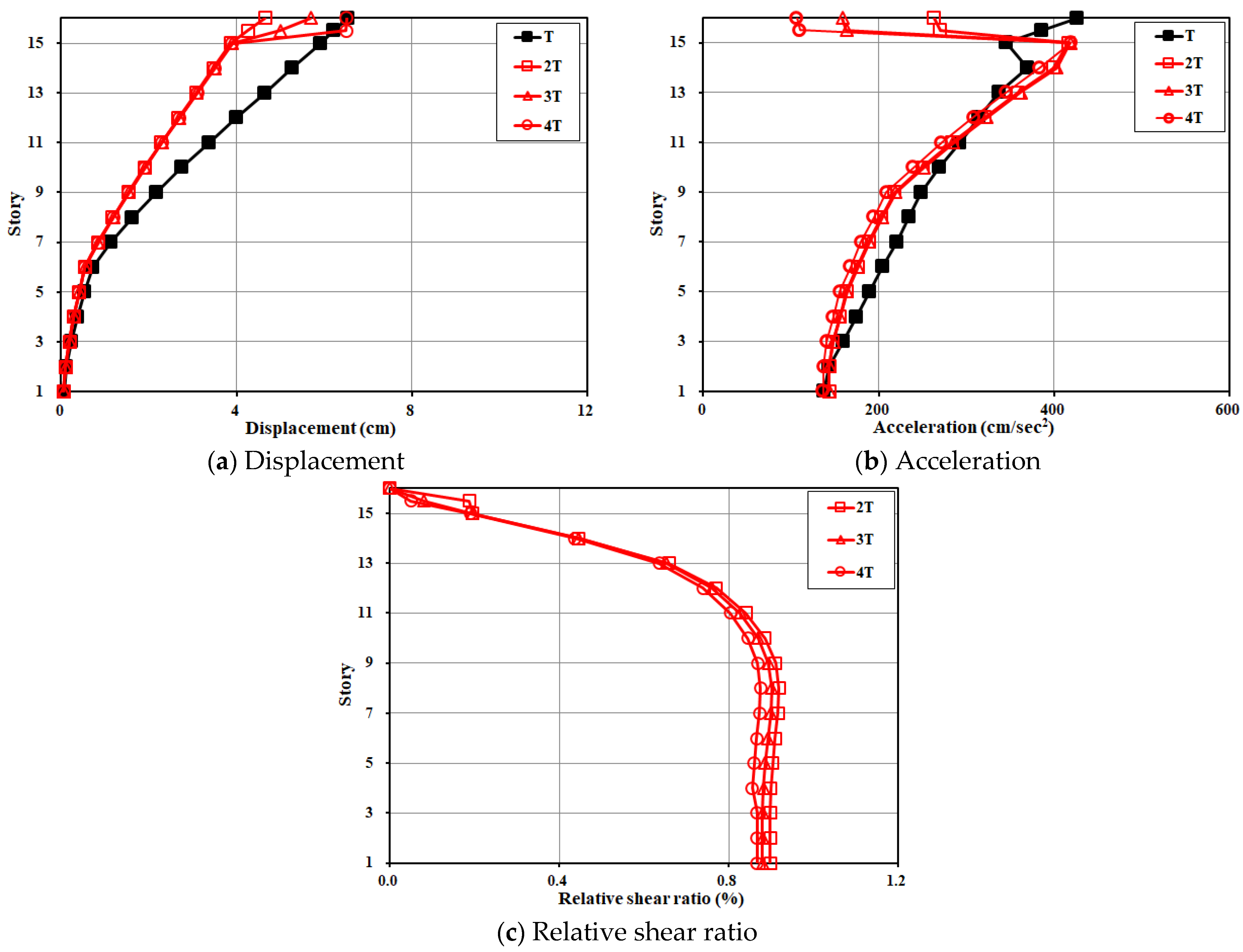

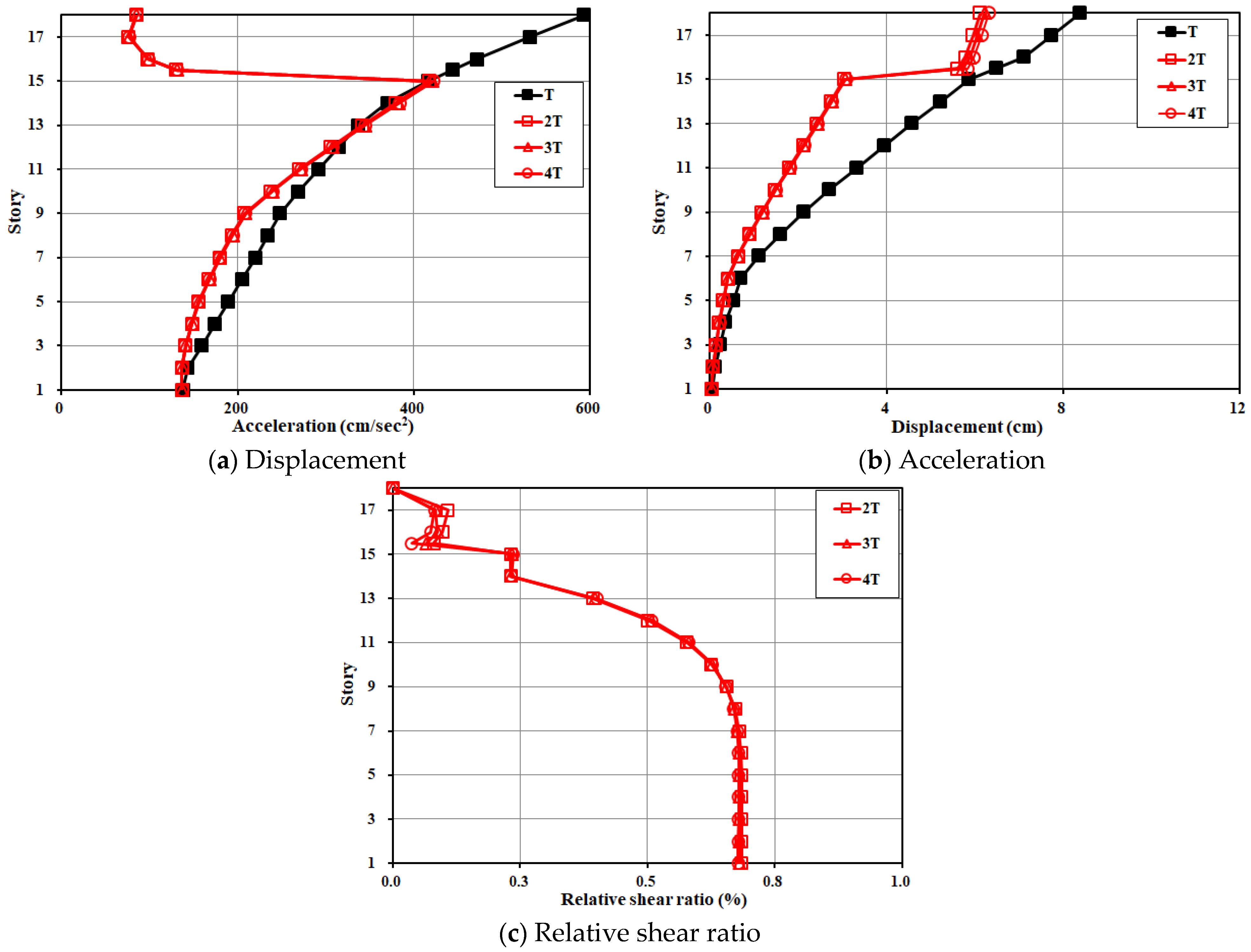
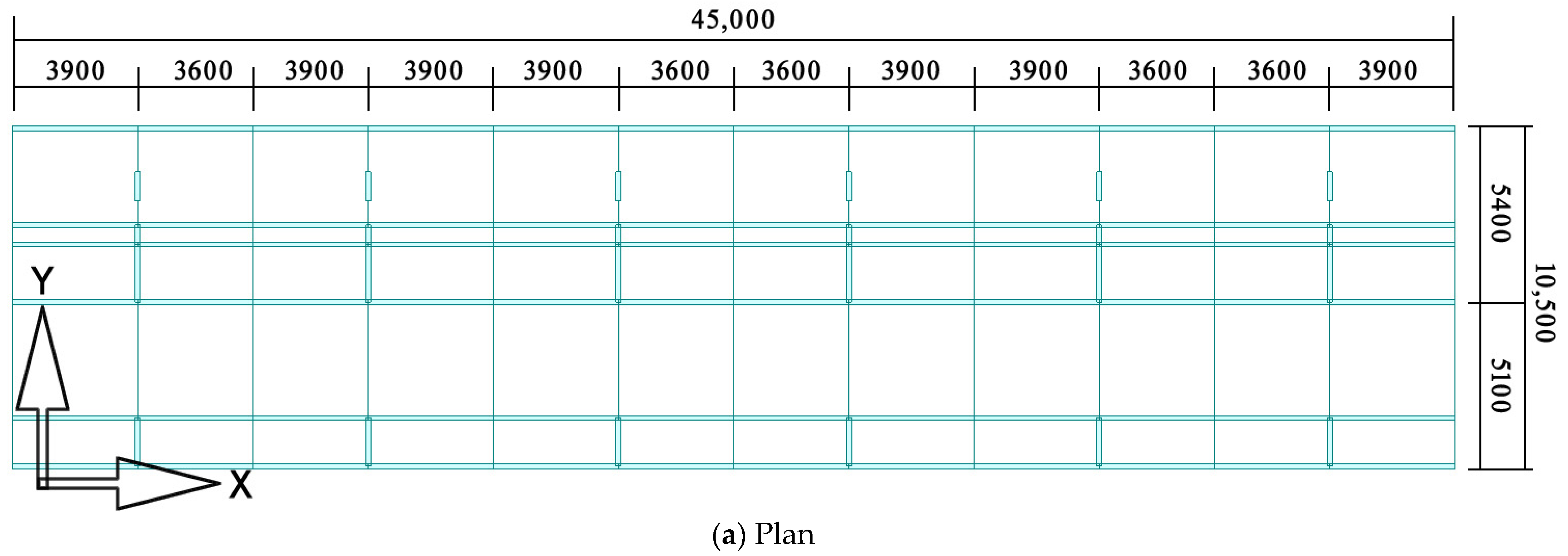
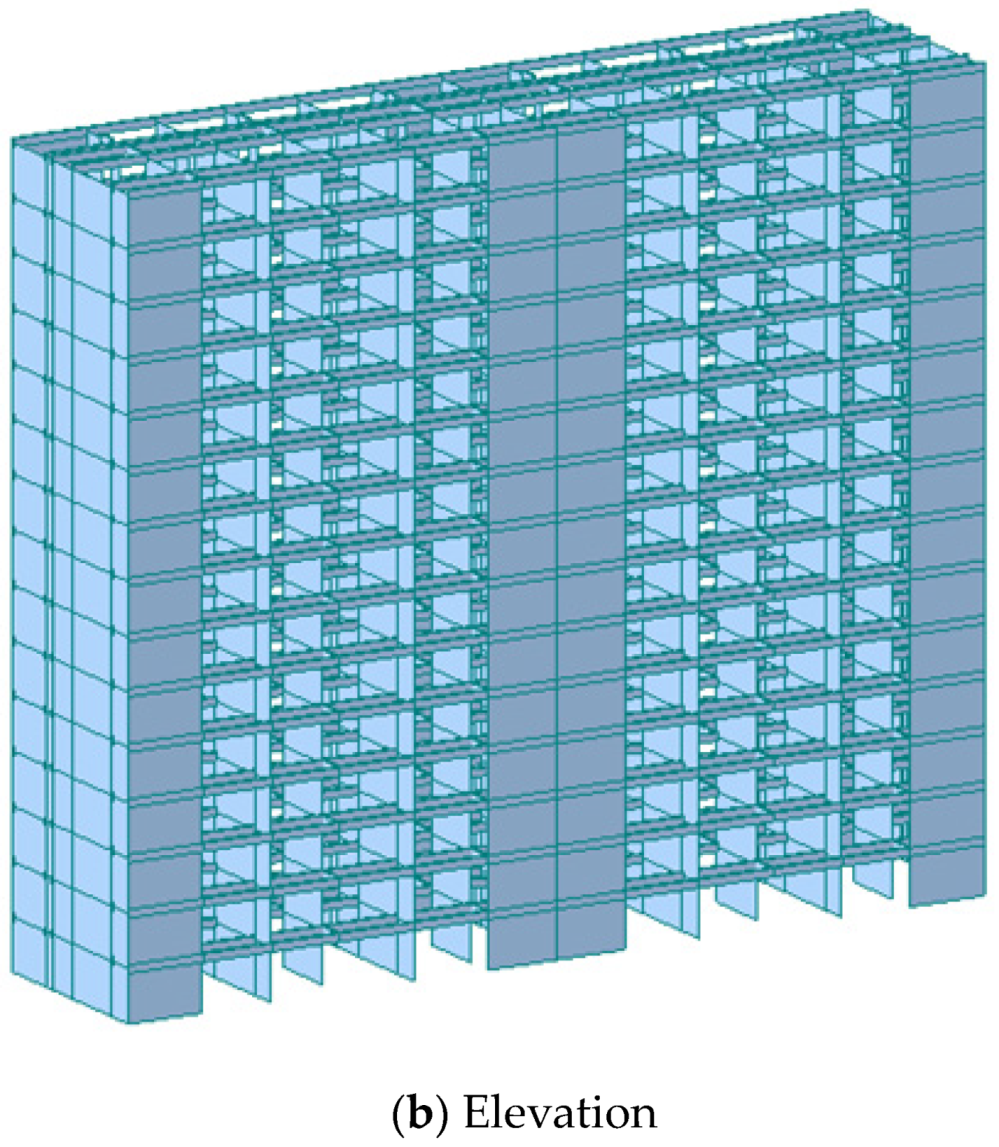
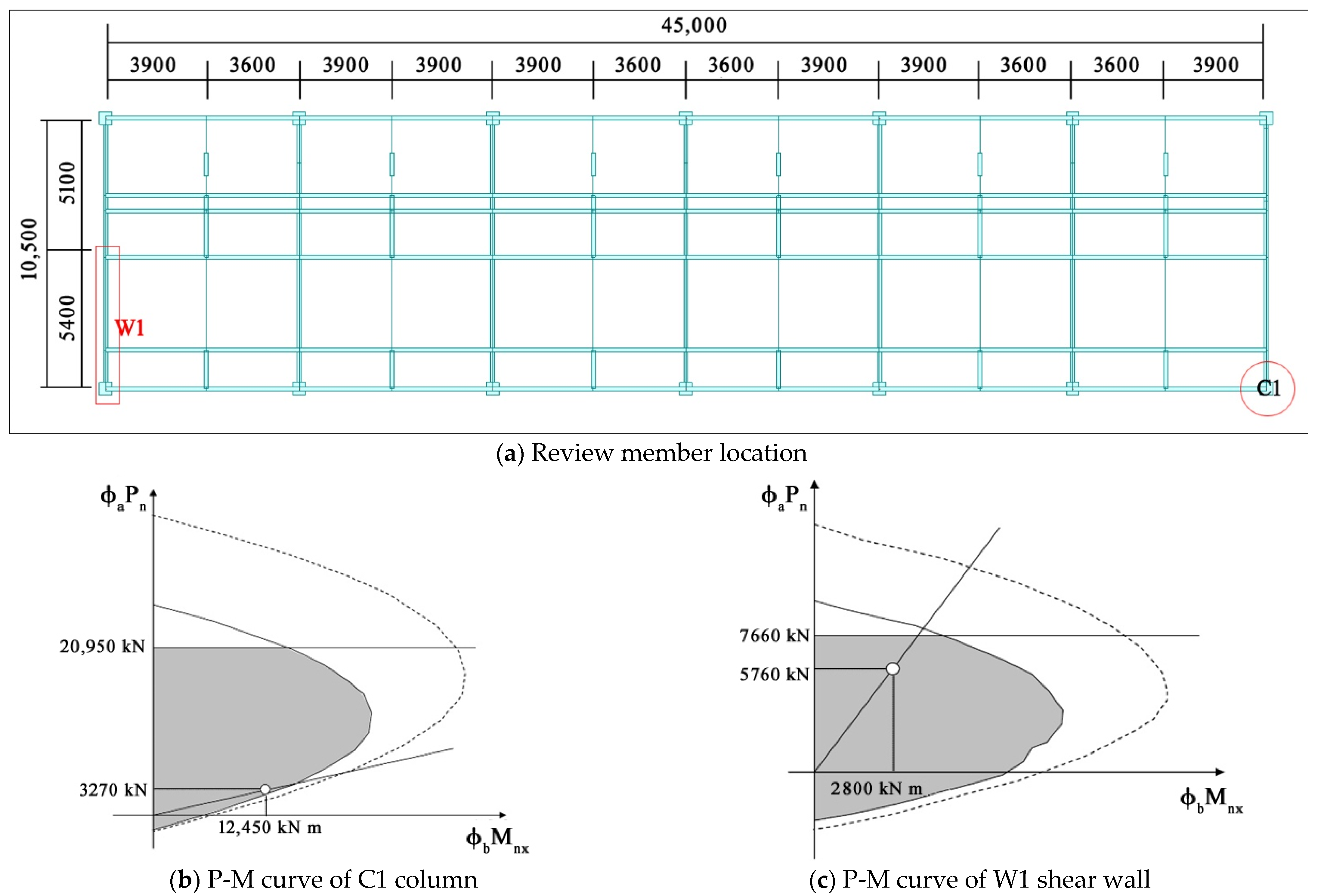
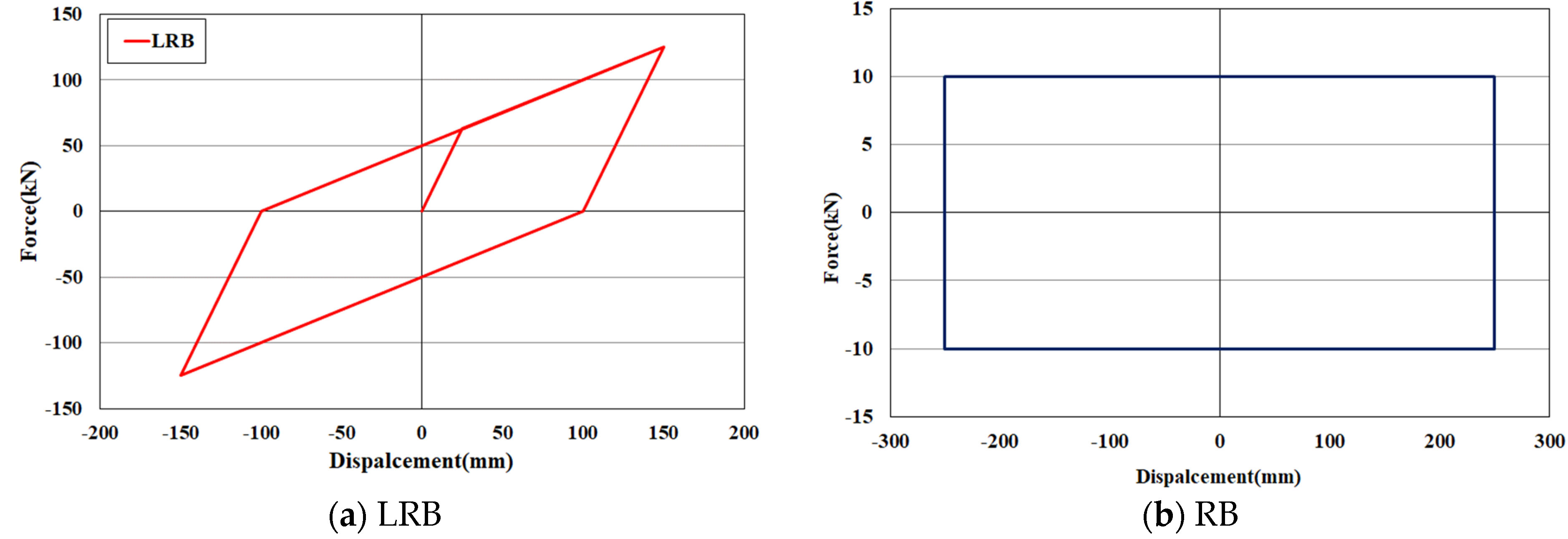
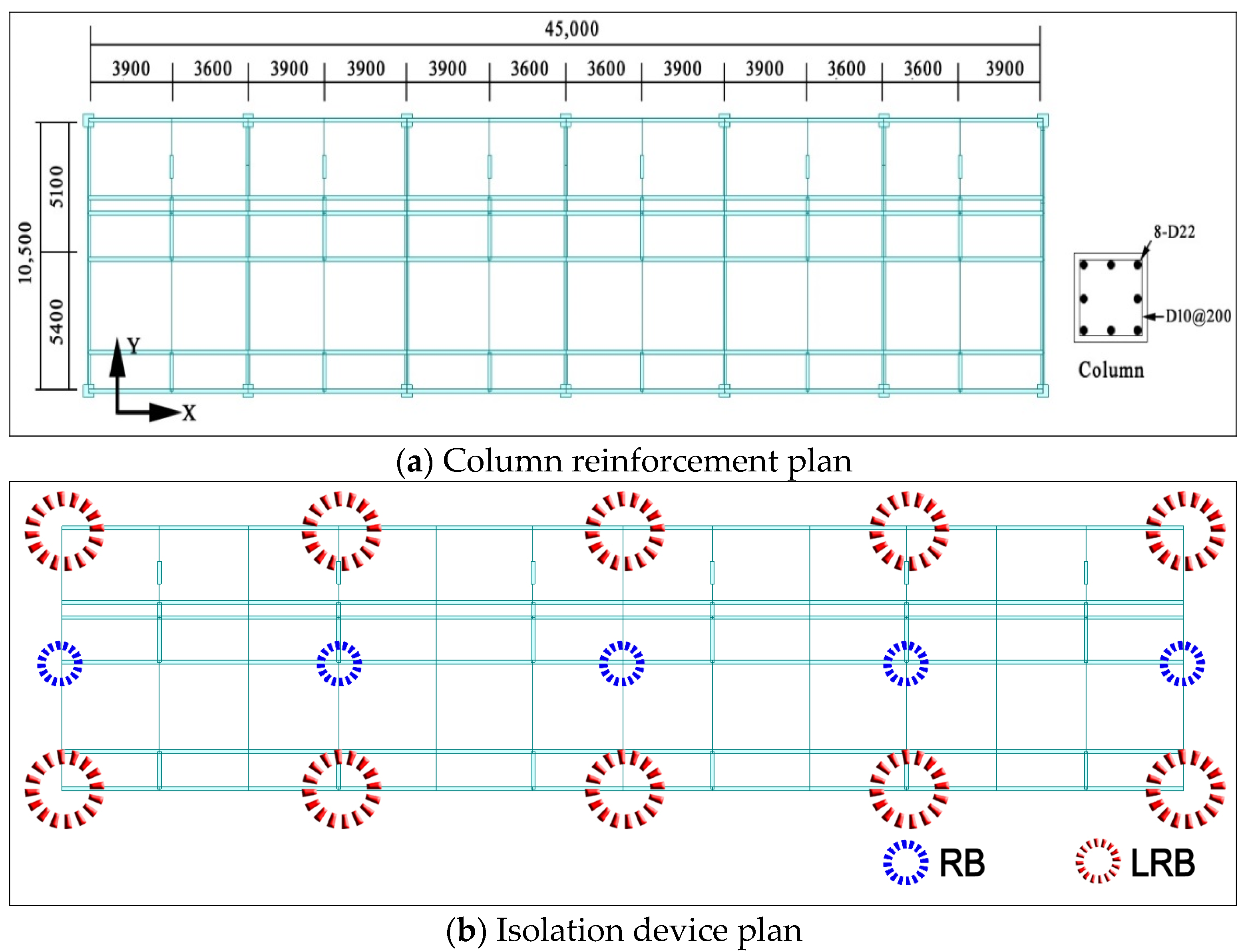
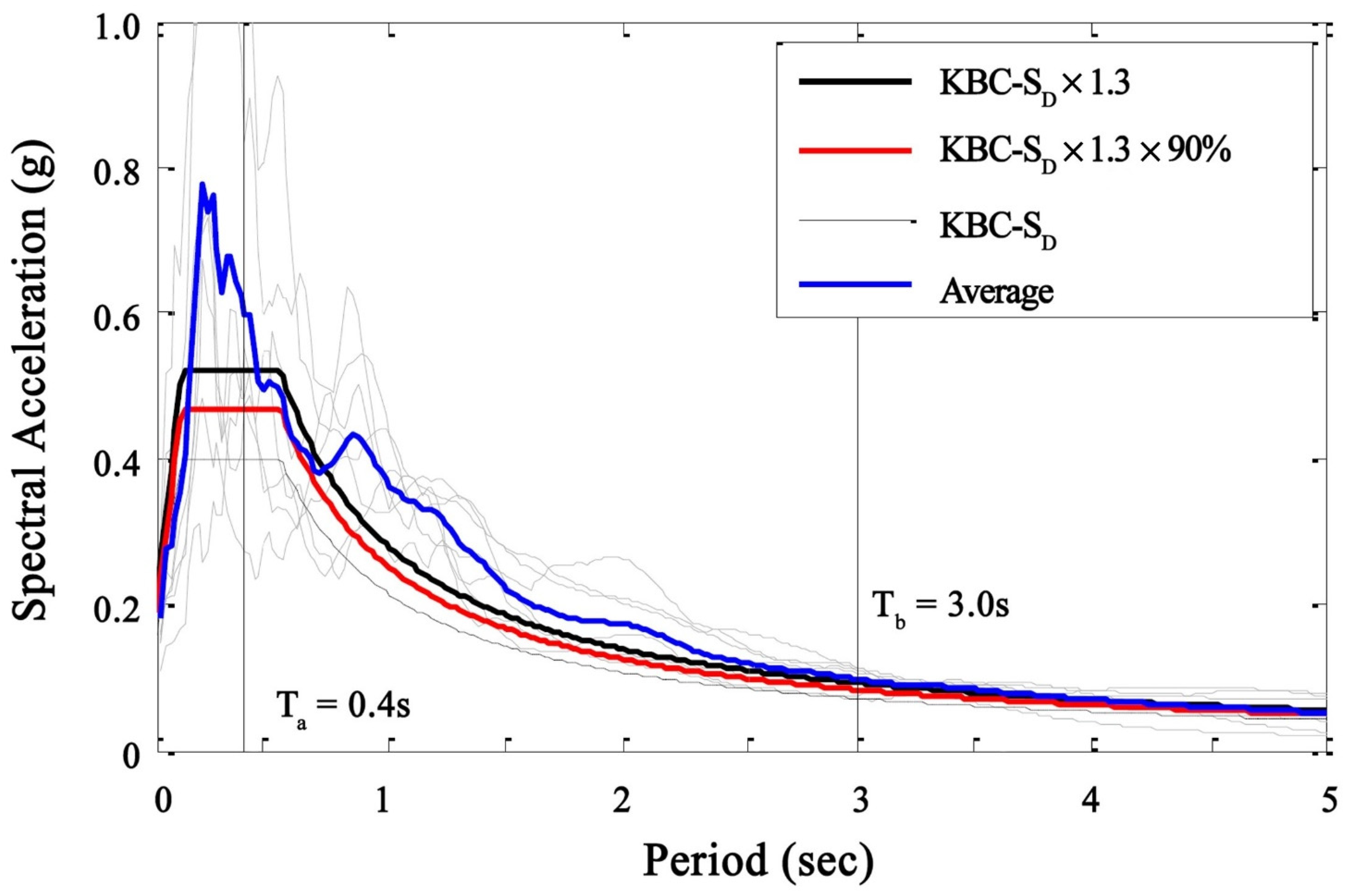

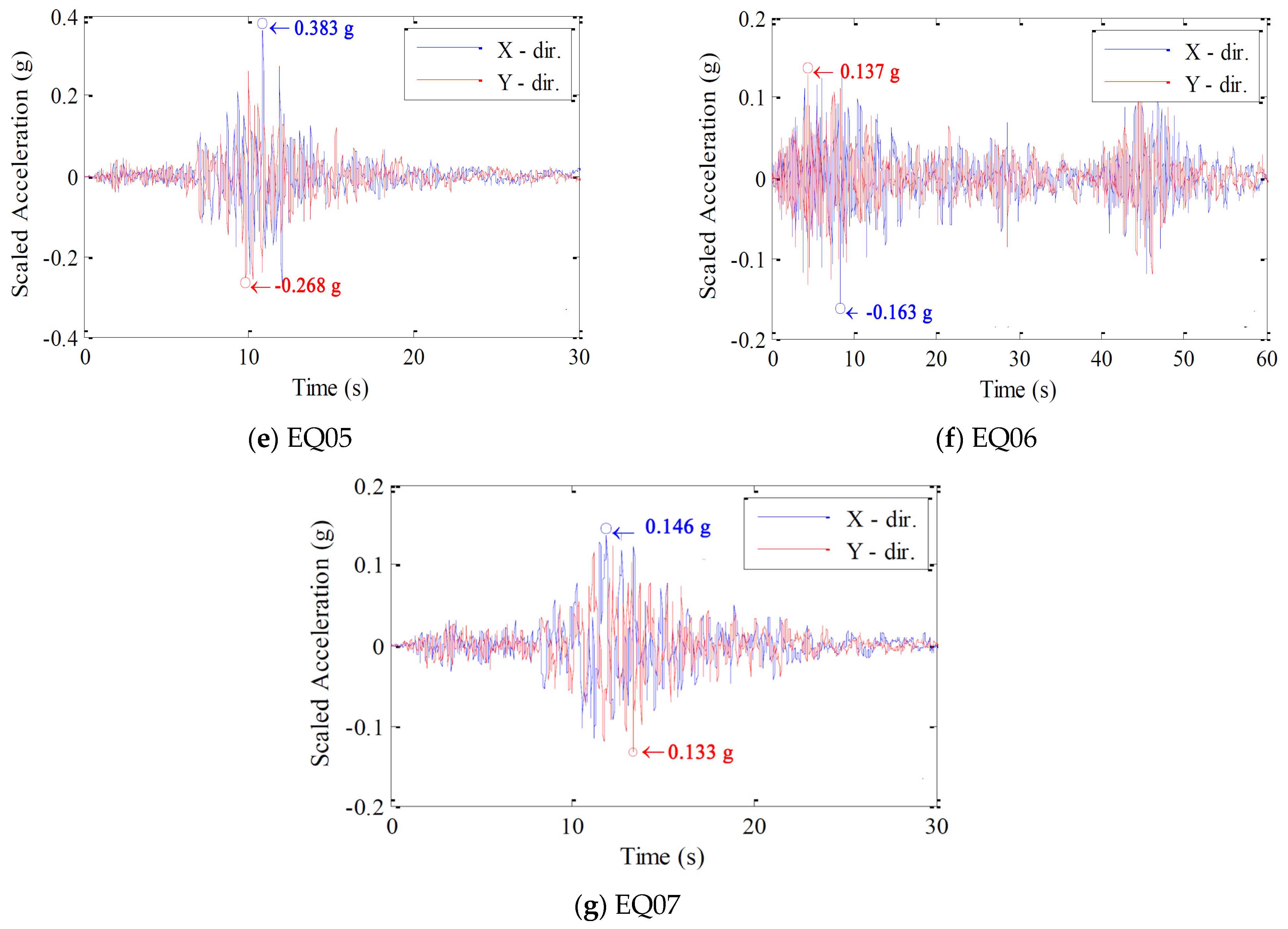
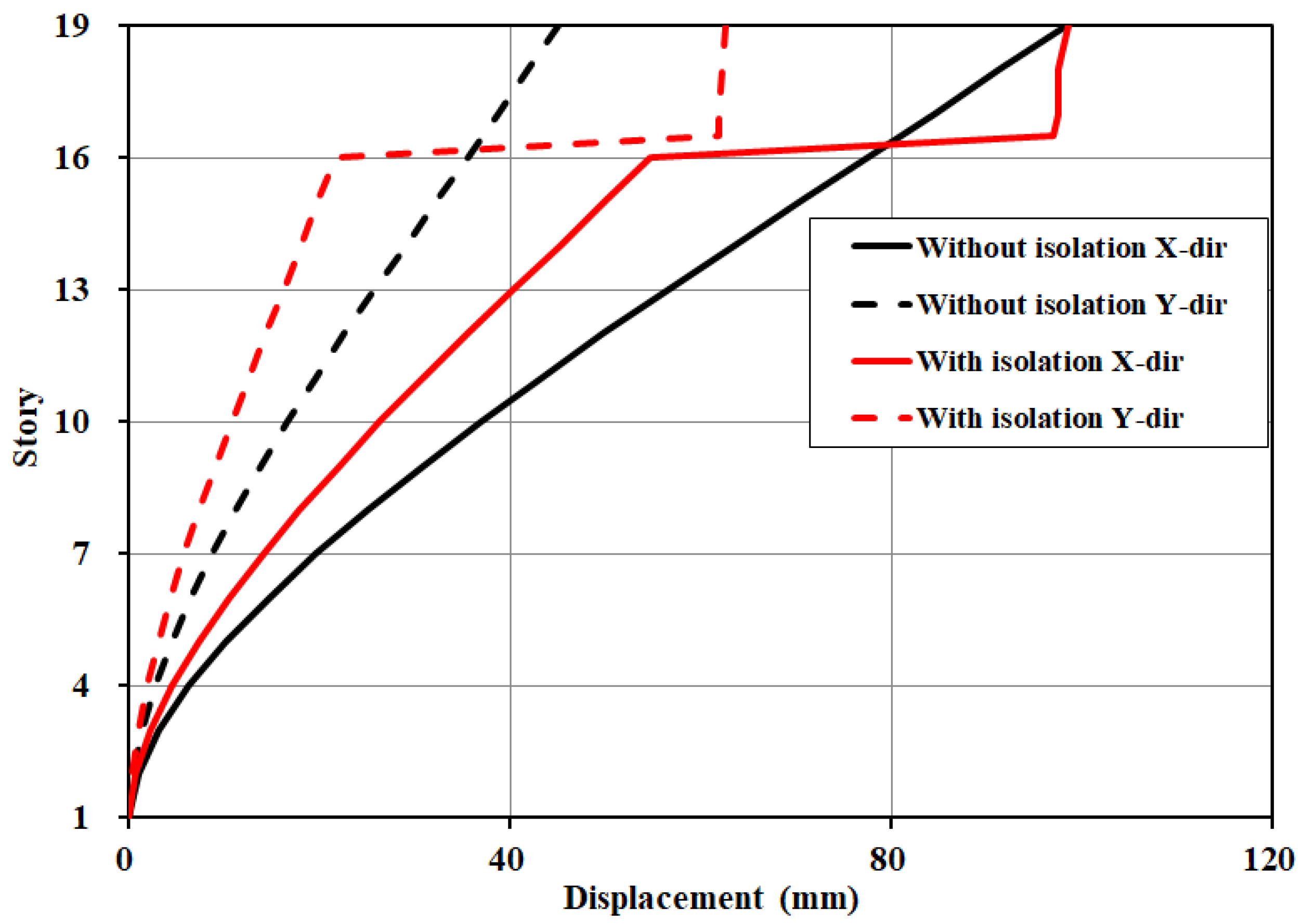

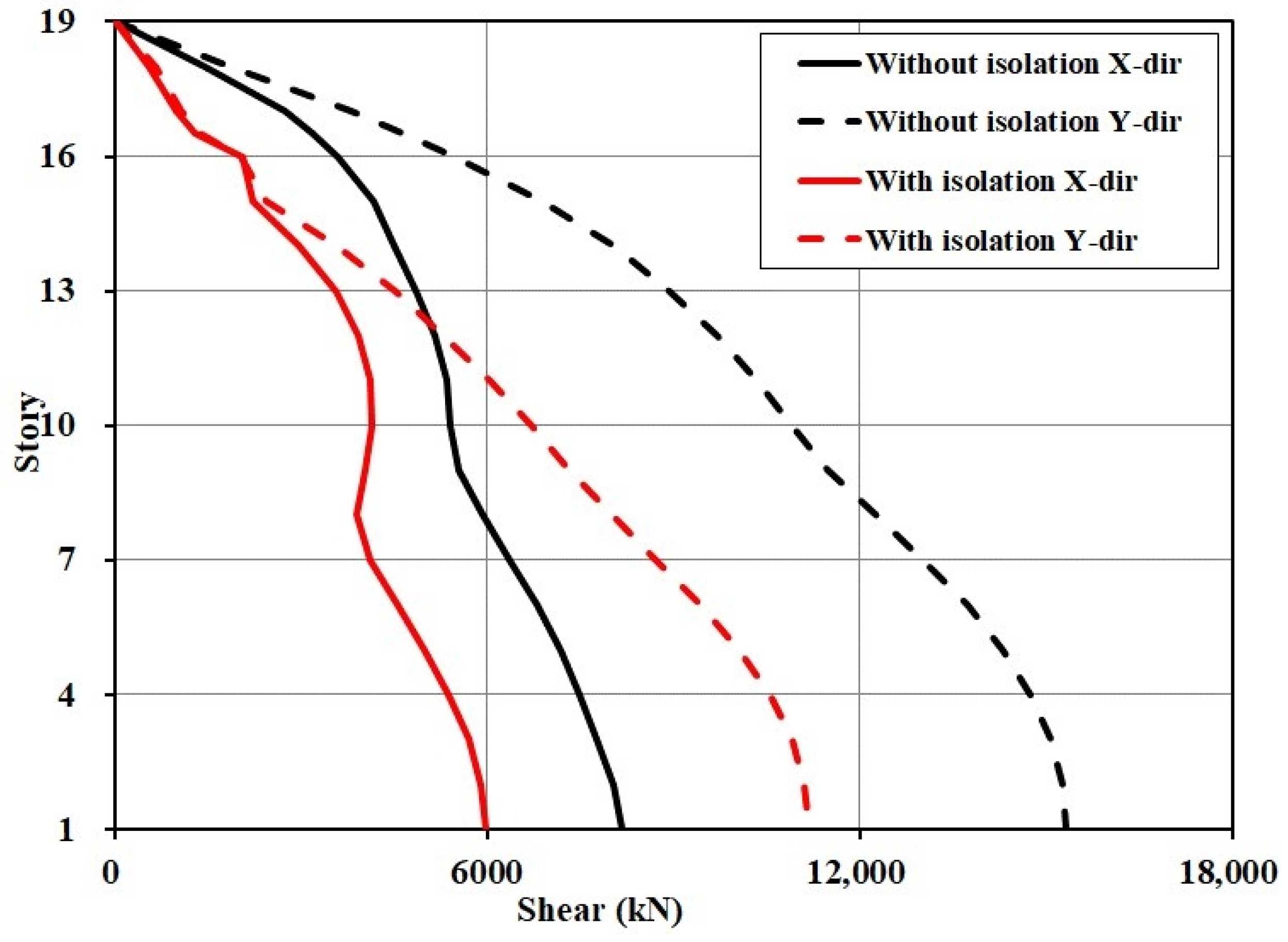

| Weight of Building | Wall | Slab | Live Load (Including Floor Finish) | Total Load | |
|---|---|---|---|---|---|
| Weight of the first floor (kN) | 2700 | 1780 | 1980 | 6460 | |
| Cross-sectional area of the wall (cm2) | 433,200 | ||||
| Before remodeling of the building (15 Stories) | Total weight of building (kN) | 40,500 | 26,700 | 29,700 | 96,900 |
| Average vertical stress of the first floor (kN/cm2) | 96,900/433,200 = 0.2237 | ||||
| After remodeling of the building (18 Stories) | Total weight of building (ton) | 46,080 | 32,760 | 37,440 | 115,380 |
| Average vertical stress of the first floor (kN/cm2) | 115,380/433,200 = 0.2663 | ||||
| Increment in vertical load | 115,380 − 96,900 = 18,480 kN | ||||
| Increment in vertical stress | 0.2237 → 0.2663 (Approximately 12.0% of Allowable Stress of the Material) | ||||
| Mode No. | Period (s) | X-Direction Mass (%) | Y-Direction Mass (%) | Z-Direction Mass (%) |
|---|---|---|---|---|
| 1 | 1.10 | 66.0 | 0.0 | 0.0 |
| 2 | 0.50 | 0.0 | 65.1 | 0.1 |
| 3 | 0.12 | 0.1 | 0.1 | 65.3 |
| Mode 1 | Mode 2 | Mode 3 | ||
 |  |  | ||
| Story | Story Level (m) | Weight (kN) | Wind (kN) | Earthquake (kN) | ||
|---|---|---|---|---|---|---|
| Force | Story Shear | Force | Story Shear | |||
| Roof | 39.0 | 3702.3 | 12.2 | 0.0 | 839.0 | 0.0 |
| 15F | 36.4 | 4334.3 | 24.3 | 12.2 | 908.4 | 839.0 |
| 14F | 33.8 | 4334.3 | 23.9 | 36.4 | 835.3 | 1747.5 |
| 13F | 31.2 | 4334.3 | 23.3 | 60.3 | 762.9 | 2582.8 |
| 12F | 28.6 | 4334.3 | 22.8 | 83.7 | 691.4 | 3345.8 |
| 11F | 26.0 | 4334.3 | 22.2 | 106.4 | 620.6 | 4037.1 |
| 10F | 23.4 | 4334.3 | 21.6 | 128.6 | 550.8 | 4657.7 |
| 9F | 20.8 | 4334.3 | 20.9 | 150.2 | 482.1 | 5208.6 |
| 8F | 18.2 | 4334.3 | 20.2 | 171.1 | 414.4 | 5690.6 |
| 7F | 15.6 | 4334.3 | 19.4 | 191.3 | 348.0 | 6105.0 |
| 6F | 13.0 | 4334.3 | 18.9 | 210.7 | 283.1 | 6453.1 |
| 5F | 10.4 | 4334.3 | 18.8 | 229.7 | 219.9 | 6736.2 |
| 4F | 7.8 | 4334.3 | 18.8 | 248.5 | 158.8 | 6956.1 |
| 3F | 5.2 | 4334.3 | 18.8 | 267.4 | 100.3 | 7114.8 |
| 2F | 2.6 | 4334.3 | 18.8 | 286.2 | 45.8 | 7215.2 |
| 1F | 0.0 | - | - | 305.1 | - | 7260.9 |
| LRB (Lead Rubber Bearing) | RB (Rubber Bearing) | |
|---|---|---|
| Outer diameter (D, mm) | 500 | 400 |
| Lead bar diameter (Di, mm) | 90 | 15 |
| Rubber thickness (mm) | 4.0 | 3.2 |
| No. of rubber layer | 25 | 25 |
| Total rubber thickness (mm) | 100 | 80 |
| Steel plate thickness (mm) | 3.2 | 3.2 |
| First Shape factor S1 | 31.3 | 30.1 |
| Second Shape factor S2 | 5.0 | 5.0 |
| Lateral stiffness (kN/mm) | 0.9 | - |
| Effective Damping, βD or βM (Percentage of Critical) | BD or BM Factor |
|---|---|
| ≤2 | 0.8 |
| 5 | 1.0 |
| 10 | 1.2 |
| 20 | 1.5 |
| 30 | 1.7 |
| No. | Event | Country | Year | Station | M | Vs, 30 |
|---|---|---|---|---|---|---|
| 1 | Chi-Chi | Taiwan | 1999 | HWA003 | 7.6 | 789 |
| 2 | Chi-Chi | Taiwan | 1999 | TAP067 | 7.6 | 808 |
| 3 | Chi-Chi | Taiwan | 1999 | ILA015 | 7.6 | 783 |
| 4 | Chi-Chi-06 | Taiwan | 1999 | HWA003 | 6.3 | 1526 |
| 5 | Loma Prieta | USA | 1989 | Piedmont Jr High School Grounds | 6.9 | 895 |
| 6 | Campano-Lucano | Italy | 1980 | Bisaccia | 6.9 | 958 |
| 7 | Loma Prieta | USA | 1989 | SF-Pacific Heights | 6.9 | 1250 |
| Story | Displacement (mm) | Acceleration (mm/s2) | Shear (kN) | |||||||||
|---|---|---|---|---|---|---|---|---|---|---|---|---|
| Without Isolation | With Isolation | Without Isolation | With Isolation | Without Isolation | With Isolation | |||||||
| X-Dir | Y-Dir | X-Dir | Y-Dir | X-Dir | Y-Dir | X-Dir | Y-Dir | X-Dir | Y-Dir | X-Dir | Y-Dir | |
| 19 | 99 | 45 | 99 | 63 | 3873 | 4893 | 1247 | 1722 | 0 | 0 | 0 | 0 |
| 18 | 92 | 42 | 98 | 63 | 2969 | 4337 | 1253 | 1718 | 1470 | 1885 | 557 | 664 |
| 17 | 85 | 39 | 98 | 62 | 2240 | 3810 | 1238 | 1727 | 2749 | 3825 | 1002 | 1086 |
| 16.5 | 81 | 37 | 97 | 62 | 2058 | 3565 | 1245 | 1710 | 3186 | 4662 | 1284 | 1387 |
| 16 | 78 | 36 | 55 | 22 | 1875 | 3320 | 2616 | 3844 | 3622 | 5499 | 2059 | 2031 |
| 15 | 71 | 32 | 50 | 20 | 1726 | 2998 | 2013 | 3315 | 4190 | 6904 | 2230 | 2454 |
| 14 | 64 | 29 | 46 | 18 | 1855 | 2832 | 1426 | 2949 | 4518 | 8061 | 2983 | 3586 |
| 13 | 57 | 26 | 41 | 16 | 2102 | 2702 | 1017 | 2702 | 4887 | 8991 | 3588 | 4539 |
| 12 | 50 | 23 | 36 | 14 | 2254 | 2648 | 1152 | 2522 | 5170 | 9756 | 3953 | 5324 |
| 11 | 44 | 20 | 31 | 13 | 2414 | 2674 | 1484 | 2395 | 5368 | 10,389 | 4122 | 6053 |
| 10 | 37 | 17 | 26 | 11 | 2550 | 2655 | 1769 | 2348 | 5439 | 10,966 | 4150 | 6747 |
| 9 | 31 | 14 | 22 | 9 | 2631 | 2598 | 1966 | 2292 | 5567 | 11,542 | 4044 | 7369 |
| 8 | 25 | 11 | 18 | 7 | 2635 | 2466 | 2058 | 2193 | 5964 | 12,302 | 3909 | 8034 |
| 7 | 20 | 9 | 14 | 6 | 2534 | 2287 | 2017 | 2062 | 6387 | 13,095 | 4144 | 8751 |
| 6 | 15 | 7 | 11 | 4 | 2357 | 2056 | 1860 | 1882 | 6826 | 13,791 | 4575 | 9469 |
| 5 | 10 | 5 | 7 | 3 | 2088 | 1815 | 1665 | 1723 | 7225 | 14,373 | 5009 | 10,098 |
| 4 | 6 | 3 | 5 | 2 | 1794 | 1599 | 1481 | 1579 | 7530 | 14,830 | 5413 | 10,602 |
| 3 | 3 | 1 | 2 | 1 | 1553 | 1460 | 1402 | 1474 | 7794 | 15,151 | 5743 | 10,955 |
| 2 | 1 | 1 | 1 | 0 | 1418 | 1404 | 1412 | 1437 | 8065 | 15,334 | 5933 | 11,160 |
| 1 | 0 | 0 | 0 | 0 | 1456 | 1456 | 1456 | 1456 | 8196 | 15,405 | 6005 | 11,240 |
Publisher’s Note: MDPI stays neutral with regard to jurisdictional claims in published maps and institutional affiliations. |
© 2022 by the authors. Licensee MDPI, Basel, Switzerland. This article is an open access article distributed under the terms and conditions of the Creative Commons Attribution (CC BY) license (https://creativecommons.org/licenses/by/4.0/).
Share and Cite
Hur, M.-W.; Park, T.-W. Seismic Performance of Story-Added Type Buildings Remodeled with Story Seismic Isolation Systems. Buildings 2022, 12, 270. https://doi.org/10.3390/buildings12030270
Hur M-W, Park T-W. Seismic Performance of Story-Added Type Buildings Remodeled with Story Seismic Isolation Systems. Buildings. 2022; 12(3):270. https://doi.org/10.3390/buildings12030270
Chicago/Turabian StyleHur, Moo-Won, and Tae-Won Park. 2022. "Seismic Performance of Story-Added Type Buildings Remodeled with Story Seismic Isolation Systems" Buildings 12, no. 3: 270. https://doi.org/10.3390/buildings12030270
APA StyleHur, M.-W., & Park, T.-W. (2022). Seismic Performance of Story-Added Type Buildings Remodeled with Story Seismic Isolation Systems. Buildings, 12(3), 270. https://doi.org/10.3390/buildings12030270






